In the realm of technological progress, few pursuits captivate the imagination quite like the development of robotics that leverage fundamental physics to accomplish highly specialized tasks. The concept of a robot that can intuitively pick locks, rooted in the principles of mechanics and sensor feedback, epitomizes this frontier of innovation. Such projects are not merely about automating a skill; they symbolize the broader human aspiration to perfect craftsmanship through precision engineering and artificial intelligence. The fascination with lock picking, long regarded as a skill that merges finesse and knowledge, is now poised to be transformed by machines capable of mimicking, or even surpassing, human intuition.
What’s compelling about this pursuit isn’t solely the technical challenge but the philosophical implications. It questions the boundaries between manual dexterity and automated intelligence. Historically, lock picking has been associated with both illicit activity and skillful craftsmanship, a duality that underscores its cultural significance. Elevating this craft into the domain of robotics could democratize access, expand its applications, and even raise ethical questions about security and privacy. Nevertheless, at its core, the effort to create a robot that can decipher the nuanced tension within a lock’s mechanisms indicates a remarkable leap toward machines that understand physics the way humans do—by sensing, adapting, and acting accordingly.
The Technical Roadblocks and the Persistent Spirit of Experimentation
Behind the glamorized narrative of robotic lock pickers lies a complex web of technical hurdles. Projects such as Sparks and Code’s efforts exemplify this relentless curiosity. Their approach involves building a robot that doesn’t simply brute-force locks but intelligently senses the mechanical resistance within the lock’s pins and barrels. By detecting tension, the robot aims to apply precise pressure, mimicking the delicate touch of an expert lockpicker. This concept is rooted in the physics of mechanics: understanding how forces transfer through the lock’s internal components and responding dynamically is a game-changer. It represents a shift from blind manipulation to a data-driven, sensor-guided process—an elegant fusion of hardware and software.
However, translating this concept into a reliable machine has proven elusive. The journey from idea to tangible product is fraught with unforeseen complications. Mechanical sensors must be exquisitely sensitive, while the robot’s control algorithms need to interpret complex resistance patterns in real-time. Achieving a stable, adaptable system that can handle various lock designs and resistances is an ongoing challenge. Despite numerous tweaks and iterations, these projects often end up in failed prototypes, underscoring just how difficult it is to realize such a vision. Yet, this failure isn’t a sign of defeat but a testament to the perseverance characteristic of true innovation. Each setback refines understanding and nudges future experiments closer to success.
The Broader Implications and Future Potential of Physics-Informed Robotics
Imagining a future where robots can seamlessly pick locks based on physical sensing opens doors to transformative applications beyond hobbyist tinkering. Security systems could be designed with an understanding that future automated tools will be able to adapt and bypass traditional defenses, prompting a new paradigm in lock and security technology. Conversely, such innovations could be harnessed for legitimate uses—automating safe cracking in a lawful context or advancing biometric security systems.
More broadly, integrating physics fundamentals into robotics exemplifies a broader trend toward machines that understand the physical world more profoundly. Instead of relying solely on pre-programmed sequences, these robots will interpret their environment, learn from resistance patterns, and develop adaptive strategies. This approach aligns with overarching goals in robotics: creating machines capable of nuanced interaction with the physical universe, moving closer to genuine artificial intelligence.
However, it’s crucial to approach this technological evolution with an awareness of ethical and societal implications. As robotics become more adept at manipulating physical systems, questions of legality, privacy, and security become more pressing. Yet, the ongoing experimentation—despite its current setbacks—serves as a vital catalyst for future breakthroughs. It signals a willingness to push boundaries, to challenge the limits of current technology, and to explore innovative intersections between physics, engineering, and artificial intelligence. Such efforts, even when imperfect, pave the way for a future where robotic systems might transcend their traditional boundaries and unlock new potentials across diverse fields.

